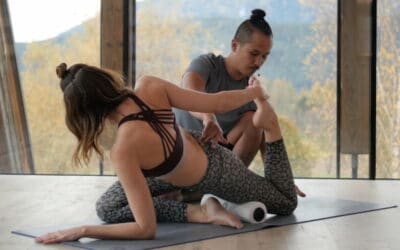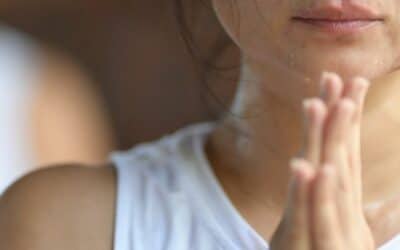When you think about backbends in yoga, mixed feeling may emerge. You may feel excited, nervous, or even anxious. Extending the spine backward means that you have to learn to distinguish between muscular challenges and unsafe joint pain.
While most of us picture really strong, deep backbends such as Wheel pose (Urdhva Dhanurasana), you may find that Camel pose (Ustrasana) is much more accessible to you or your students. It’s a great exercise not only for your body, but also for your mind since this asana teaches you to let go of your ego in your yoga practice instead of forcing your body into an Instagram-worthy position for which it may not be ready yet.
“Body is not stiff, mind is stiff.”
This artcile will help you to understand how to practice Camel pose safely:
1. How Do You Get Into Camel Pose Safely?
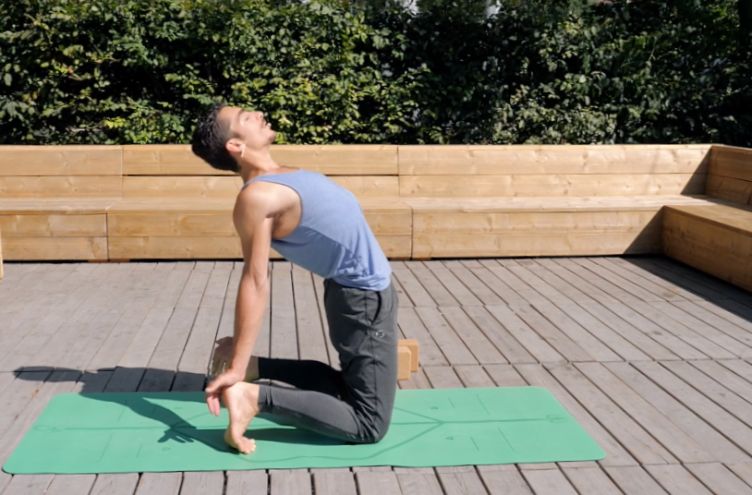
Bend back into Camel pose asana with Matt Giordano on TINT.
- Camel is an asana where the entry is very important: Kneel on your mat with your knees hip-width apart.
- Tuck your toes and widen your feet so that they are about mat-width apart. This helps you to inwardly rotate your thighs.
- Place your hands onto your waistline and push your buttocks back. You can even make a little duck butt.
- Bring your bent elbows towards each other to open your chest.
- Pull up your pubic bone so that your pelvis moves back (posterior tilt).
- Push your buttocks forward until you feel a gentle stretch on your thighs.
- Bring your feet back in so that your shins are parallel to each other.
- Lift your chest and move your shoulders up and back.
- Now is the time when you release your hands. Outwardly rotate your arms while you reach back to your heels.
- Bring the tips of your shoulder blades towards each other by further outwardly rotating your arms.
- Imagine that you want to straighten your legs. So push down through your toes and push your femur bones (thigh bones) backwards. This creates more space in your hip flexors.
- Elevate your heart up to the ceiling.
- To come out of the pose, raise one arm up and pull yourself up. Sit down on your heels and rest.
Now it’s time for you to put the theory into practice. So, roll out your yoga mat and watch this short video where Young Ho Kim takes you step by step through Camel pose. If you want to learn more about the correct alignment in various asanas, check out his Inside Yoga Alignment program on TINT where you find detailed guidance for some of the most common asanas. There’s even a section focusing on the right & wrong of each pose.
Practice Camel pose in Young Ho Kim’s Inside Yoga Alignment on TINT.
2. What Is Your Body Doing In Camel Pose?
2.1. What Are the Joints Doing?
Camel pose is an asana where your spine is extended while your scapulae are adducted and rotate downward. The shoulder is extended and adducted and the elbow is extended, too.
In your lower limbs, the sacroiliac joint moves into counternutation, which means that the top of the sacrum tilts backward and bottom tilts forward. The hip is extended and adducted. The knees are flexed and there is plantar flexion in your ankle. The internal rotation of the legs help to stabilize the sacroiliac joint by encouraging its correct alignment.
2.2. Which Muscles Are Engaged?
Let’s start with the upper body to examine the muscles engaged in Ustrasana: In the spine, the spinal extensors are contracting concentrically in order to extend it. However, most of the action of extension is caused by gravity.
The abdominal muscles and the psoas minor are contracting eccentrically to prevent over-mobilization of the lumbar spine. The psoas major is passively lengthening.
The anterior neck muscles contract eccentrically to avoid hyperextension in the cervical spine when your head extends. On the other hand, the sternocleidomastoid should not be active so that the base of the skull is not pulled into the atlas and axis (the first two vertebrae in your cervical spine).
Let’s look at the muscular actions happening in your arms now: The rhomboids and the levator scapulae contract concentrically to adduct, elevate and downwardly rotate the shoulder. The rotator cuff muscles help to stabilize the shoulder joint and prevent the head of the upper arm bone (humerus) from protracting.
The triceps brachii contract concentrically to extend the elbow and to extend and adduct the shoulder joint while the pectoralis major and minor as well as the biceps brachii are passively lengthening.
In your legs, the concentric contraction of the hamstrings, the adductor magnus and the gluteus maximus is responsible for the extension, adduction and internal rotation of the hip. The rectus femoris contracts eccentrically to stabilize the hip extension and knee flexion.
If you’re looking for guidance in other yoga asanas as well, check out our free yoga asana ebook. It will give you a sound understanding of the alignment basics regarding some of the most common yoga poses. A reference guide for your yoga practice you definitely don’t want to miss!
3. How Can You Make Camel Pose A Safe Backbend?
1. Tuck Your Toes
The first question in Camel pose is where to put the feet in this asana: Should you point them or tuck your toes? The thing is, when you tuck your toes, it’s much easier to engage your leg muscles. And you need strong leg muscles in order to elevate your heart and avoid sinking into the pose. If you push your toes into the ground, you create power to lift your heart up towards the ceiling.
2. Outwardly Rotate Your Arms
You may often see people grabbing their heels with the fingers on the outsides of the feet and the thumbs on the insides. However, this means that your arms are inwardly rotated and, as a result, your shoulders are closed forward. This is not a healthy alignment for a backbend.
Instead, outwardly rotate your arms. So, switch the position of your hands so that your fingers are inside your heels and the thumbs are placed on the outsides. Bring your shoulders up to your ears and move the tips of the shoulder blades (scapulae) towards each other.
3. Avoid Hyperextending The Neck
Many people hyperextend their neck in Ustrasana. This means that, while your throat is open widely, you compress the backside of your neck and, thus, also your windpipe.
Lift your head a little bit instead, which means, of course, that you need more muscle strength in the neck. This will keep your neck wrinkle-free and not impede your airway.
4. Push Your Thigh Bones Backward
A very common instruction in Camel pose in yoga is to push the hip and the thighs forward. What happens when you do that is that you create compression in your lower back. However, you don’t want to create pain in your body and backbends are a quite common cause of back pain.
What you should do instead is pushing your thigh bones backward without moving your hip. This may be a quite difficult movement to coordinate. So, imagine that you want to straighten your legs. This action will make you push your femur bones backward.
Always remember that Camel pose is an asana that creates a deep backbend. So there are two movements that are essential to healthy alignment in this pose:
- Inward rotation of the thighs, and
- Outward rotation of the upper arms.
However, since it is very difficult to inwardly the thighs while you’re in the pose, it’s best to do this when you enter into Ustrasana by bringing the feet (with tucked toes) further away from each other, about mat-width distance.
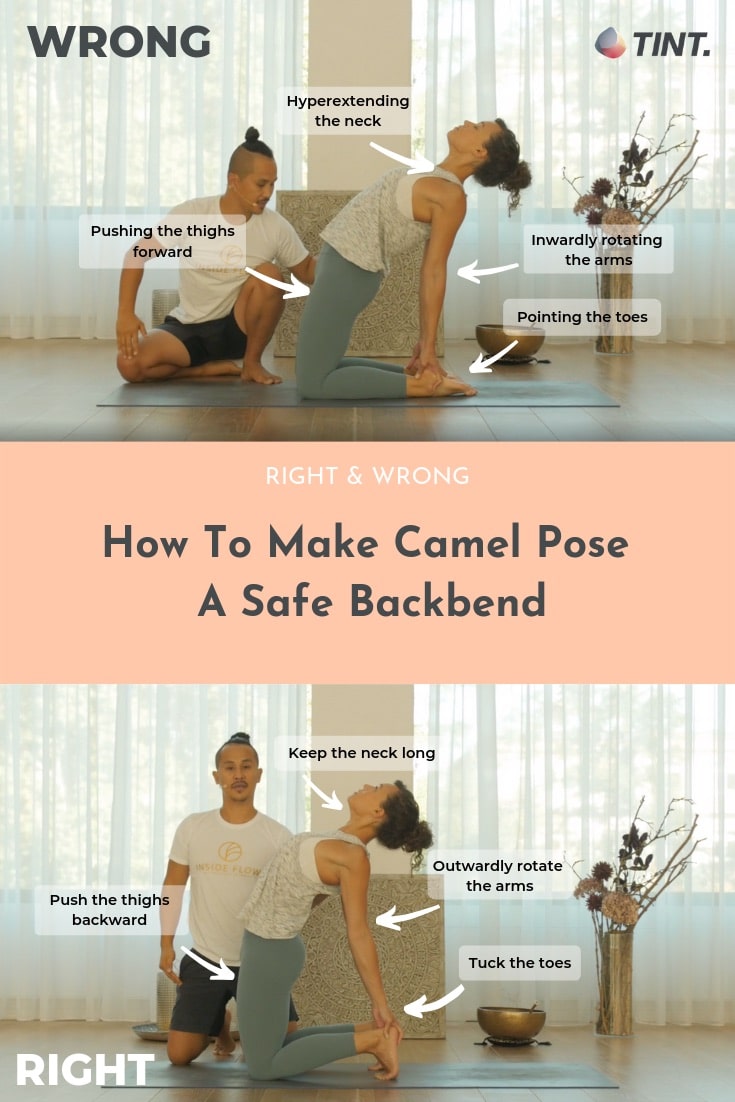
Learn how to do Camel pose in yoga with Young Ho Kim’s Inside Yoga Alignment.
4. How Can You Adapt Camel Pose To Your Yoga Practice?
Although Camel pose can be an asana that is very energizing and helps you gain spinal flexibility, it’s important to never to force your body into the pose. It may be a good idea to prepare your body by specifically warming for backbends. Young Ho Kim provides a well-rounded and safe warm-up sequence for backbends on TINT.
You can also check out our Yoga For Neck & Shoulders to gain the strength and flexibility needed in the neck and shoulders.
Prepare your neck and shoulders for Camel pose with TINT.
Until you have gained the flexibility and strength you need to safely go into this backbend, you can adapt this yoga pose to your needs. There are several ways to adapt Ustrasana to your yoga practice, for example by performing Camel pose with props:
- If you have difficulties reaching your feet, you can place yoga blocks on the outsides of the feet to rest your hands on. If this is still difficult, you can place a chair behind you and reach for the chair with your hands.
- If your neck is sensitive, you can practice Camel pose on a wall as a prop to protect your neck. Face the wall with your back, tuck your toes and place the soles as close to the wall as possible. When you lean back, press the crown of your head into the wall and use this pressure to bring the tips of your shoulder blades closer together.
- To deepen Camel pose using blocks, you can also press a block on your inner thighs. Use your legs to move the block back and engage your legs by squeezing the block. As a result, you will not arch your back simply because you stuck your buttocks out, but the backbend will really come from the legs.
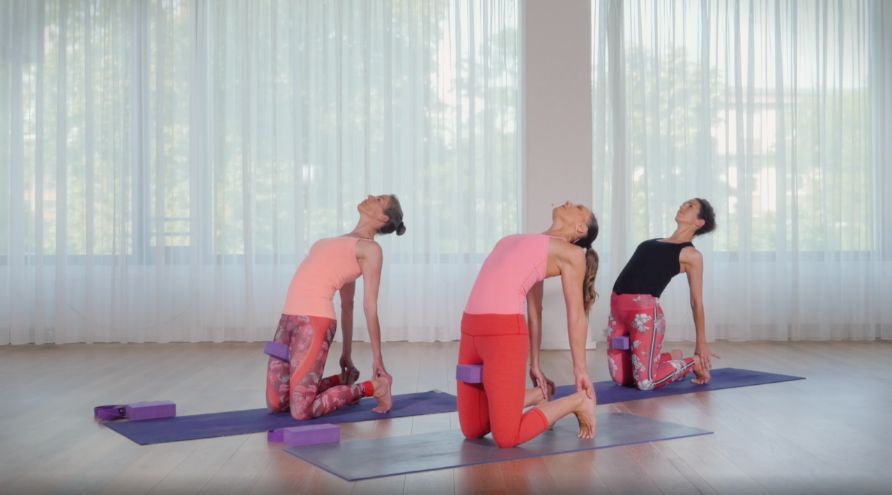
Barbra Noh shows you how to practice Camel pose with blocks in her Strength & Grace Yoga on TINT.
If you want to challenge yourself and open the chest, shoulders, and arms more, you can cross your forearms and reach for the opposite ankles.
Another variation of Ustrasana is its one-legged version, Eka Pada Ustrasana. For this, only kneel on one leg and step the other one forward into a 90 degree angle. The back toe is tucked. Hug the midline of your body with your shins and move the inner thighs back. Create a curve in the lower back and lift up through your waistline. Outwardly rotate the arms and lift your heart.
You can either stay here with the arms reaching out to the sides, palms facing upward for the outward rotation, or you reach back for your heel with the hand of the same side. Bring the opposite arm over your head. Turn your chest towards that lifted arm so that your spine is in a symmetrical position.
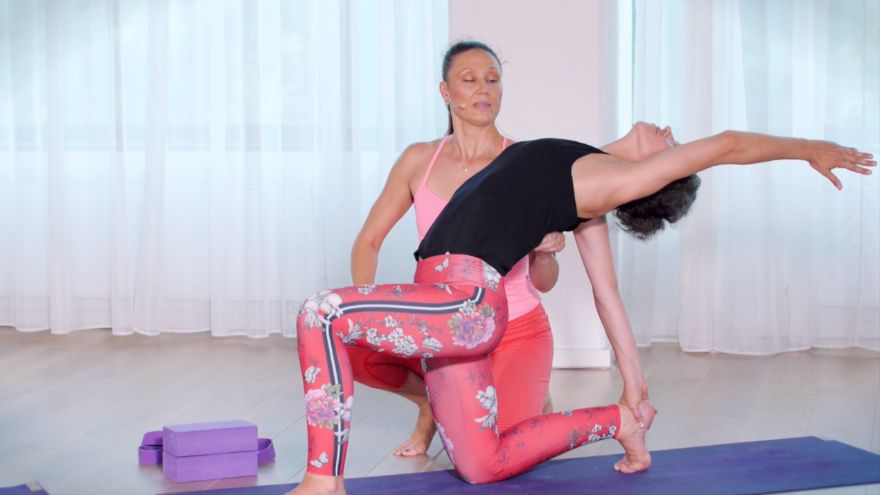
Try a one-legged version of Camel pose with Barbra Noh on TINT.
If you want to practice Camel pose in a yoga sequence, the following yoga poses are great asanas to move into before or after your Ustrasana:
- Table pose (Cakravakasana),
- Hero pose (Virasana),
- Child’s pose (Balasana), or
- Gate pose (Parighasana).
To avoid pain in your yoga practice, proper alignment is essential – especially when it comes to your back. To also avoid back pain in other back-bending yoga poses, have a look at our free yoga asana ebook. It summarizes some the most important yoga asanas, including further back-bending asanas, so you can use it as a reference guide for your practice.
5. What Are the Benefits of Camel Pose?
While your spine is meant to bend in both directions, most of us probably spend the day working in one direction only: hunched forward in front of a computer or desk. So backbends like Camel pose (Ustrasana)are a great means to restore the natural flexibility of the spine.
However, Camel pose does not only improve spinal flexibility but at the same time also strengthens the back muscles. This asana can therefore help to improve your posture.
In yoga, Camel pose is often used as preparation for deeper backbends since it stretches the whole front of the body, especially the chest, the abdominal area, the thighs, and the hip flexors.
Ustrasana also creates space in the chest and lungs and therefore can increase your breathing capacity and may even help to soothe respiratory complaints.
The intense stretch for the front body also stimulates the abdominal organs and can thus improve digestion and circulation. It is therefore said to have a detoxing effect and to be a very energizing asana.
If you are eager to experience the great benefits of backbends like Camel pose in yoga yourself, we’ve got you covered.There are several programs on TINT where you can feel the great effects that backbends can have on your flexibility, posture and overall well-being. You can, for example, practice backbends with Finlay Wilson or learn how to Master Your Backends with Mathieu Boldron. Make sure you also check out Barbra Noh‘s Bamboo Backbends . It’s time to bend!


